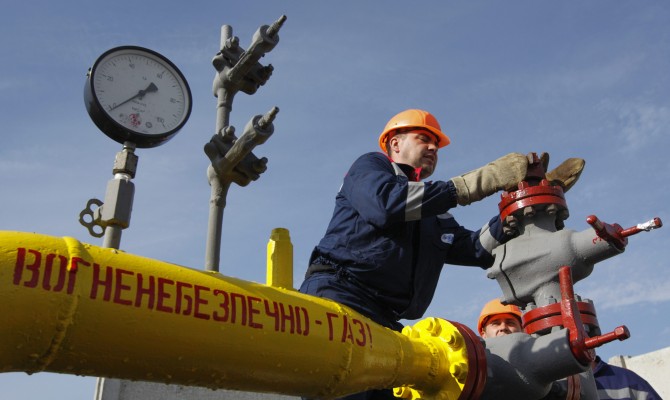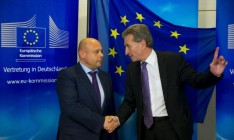Business
conflictNorwegian contract – a loophole for legalization of the reverse flow gas supply to Ukraine

First Deputy Chair of the Committee of Industry of the State Duma of Russia Vladimir Gutenev drafted a bill banning Russian companies to sell hydrocarbons to countries that are engaged in their re-export. Clearly, the ban is targeted at Hungary, Poland and Slovakia selling Ukraine the gas that was earlier purchased by the European companies from Gazprom.
Questionable reverse
In response to the inquiry submitted by Gutenev, First Vice Chair of Gazprom Aleksandr Medvedev pointed to the fact that Poland, Hungary, Slovakia and Ukraine reconstructed their gas transport systems in order to deliver raw material in the eastern direction. The Russian monopoly cannot obstruct this seeing as the infrastructure for reverse delivery does not violate the contracts between Gazprom and its European buyers.
In 2012-2014, Ukraine received 3.8 bn cu m of gas from European companies in the reverse flow mode, including 1.7 bn cu m this year alone, Gazprom informed. Ukraine’s figures are somewhat different – over nine months of 2014 Ukraine purchased from Europe 2.2 bn cu m of gas. “There are grounds to affirm that Russian natural gas targeted at European, not Ukrainian consumers, is being delivered to Ukraine, as a rule, by the scheme of so-called virtual reverse with transfer of gas through across the Ukraine-EU border. The legitimacy of such a scheme looks rather dubious,” Medvedev believes, adding that Naftogaz of Ukraine is not fulfilling the terms and conditions of the contract for the purchase of Russian raw material from Gazprom.
Cut-off is possible
“If such a law is adopted, it will work,” partner of the Russian consulting agency RusEnergy Mikhail Krutikhin told Capital. In his opinion, this is regardless of the fact that the ban on the sale of gas to “unreliable” European consumers may deal a blow to the monopolist seeing as it will lose its reputation as a reliable supplier. Gazprom will be forced to sever contracts due to force majeure circumstances and Europe will have to speed up its efforts to attaining gas independence from Russia, as German Chancellor Angela Merkel said not so long ago,” according to Krutikhin.
This is not the first time that Gazprom has accused Ukraine of the illegal purchase of Russian gas from European companies. But after such accusations Gazprom took to practical actions by limiting the supply of gas to Slovakia, Poland and Hungary in the end of September. Starting from October the company’s position towards these countries became even more stringent. For example, the Slovak national gas company SPP received on October 1-4 only half of the volume it ordered from Gazprom. As a result, European companies were forced to reduce the reverse flow supply of gas to Ukraine: Slovakia by 10%, Poland – a third and Hungary totally halted gas supplies in the reverse direction on September 26.
Scandinavian gas loophole
Despite this, the Ukrainian government found a solution announcing the signing of a contract for the supply of gas to Ukraine with the Norwegian company Statoil. “The Norwegian oil and gas company began supplying gas to Naftogaz of Ukraine through Slovakia on October 1, 2014,” the press service of the company informed last Friday. “This is a totally viable contract and the price of gas may turn out to be cheaper than Russian gas, seeing as the price of gas at the hub in Belgium is currently US $288-290 for 1,000 cu m. Even including transport and administrative costs and profits, it will be less than the US $385 per 1,000 cu m paid for Russian gas,” Krutikhin pointed out. Meanwhile, Naftogaz of Ukraine is not disclosing the price and volume of shipment of Norwegian gas as it is clear in the response of the press service of the company to the inquiry of Capital.
Vice Chairman of the Energy Strategy Foundation Dmytro Marunych believes that this contract has a more propagandistic objective, namely to demonstrate that Ukraine could have yet another alternative to Gazprom for the supply of gas on the eve of talks with Russia. The expert noted that the price and volume of gas is deliberately not being disclosed as Norwegian gas drilled in the sea is expensive – the quotations of Norwegian gas in 2013 reached US $400 per 1,000 cu m. Moreover, Norwegian gas is not physically supplied to Ukraine. For this, a substitution scheme is used.
Director of the Energy Program of the Global Economy and International Relations Center at the Academy of Sciences of Ukraine Valentyn Zemlyanskiy states that no Norwegian gas will end up in the Ukrainian pipelines. Most likely, this will be the same reverse gas of Russian origin.

Ukraine and Russia maintain positions in gas talks – reverse vs. no reverse?
67447
Ukraine may replace 5 bcm of Russian gas by reverse-flow deliveries, fuel oil – Yatseniuk
1 25591
Oettinger: Ukraine to prepay $385 per thousand cubic meters of Russian gas in winter, without "take or pay" obligation
19008



 of the agreement of syndication with Financial Times Limited are strictly prohibited. Use of materials which refers to France-Presse, Reuters, Interfax-Ukraine, Ukrainian News, UNIAN agencies is strictly prohibited. Materials marked
of the agreement of syndication with Financial Times Limited are strictly prohibited. Use of materials which refers to France-Presse, Reuters, Interfax-Ukraine, Ukrainian News, UNIAN agencies is strictly prohibited. Materials marked  are published as advertisements.
are published as advertisements.